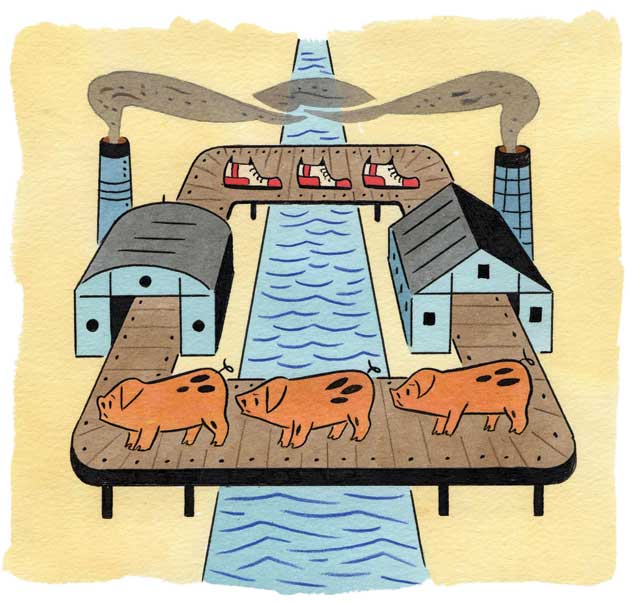While Americans eat nearly twice as much meat individually as their Chinese counterparts every year, Beth Hoffman at Forbes reports that with a population of 1.35 billion, “China now consumes double the amount of meat we do in the U.S.,” altering landscapes in the West as a result:
In the U.S. beef reigns supreme, while in China, the meat of choice is pork. More than half of the 107 million tons of pork eaten world wide in 2013 were consumed in China, a clear reason Chinese company Shuanghui International Holdings Ltd. bought the world’s largest pork producer, Smithfield Foods, last year.
[…] Soybeans, says Larsen, help to quickly and “efficiently” fatten hogs and cattle. But soybean yields are difficult to increase, which means that as more soybeans are needed, more land must be converted to make room for the legume.
That extra land is currently found in Brazil and Argentina. Since the 1990s large monoculture soy crops have graced lands where forests once stood, and today Brazil is quickly becoming the world’s leading soy producer.
[…] This massive use of herbicide in Brazil and the U.S. is also now affecting the water and air we breathe. [Source]
It’s now cheaper to produce pork in the US than in China. You read that right: Our meat industry churns out hogs for about $0.57 per pound, according to the US Department of Agriculture, versus $0.68 per pound in China’s new, factory-scale hog farms. The main difference is feed costs. US pig producers spend about 25 percent less on feed than their Chinese counterparts, the USDA found, because the “United States has more abundant land, water, and grain resources.”
Americans are not as fond of “the other white meat” as we once were. You wouldn’t know it from the menus in trendy restaurants, but US consumers’ appetite for pork hit a peak in 1999 and has declined ever since. Yet industry, beholden to shareholders demanding growth, keeps churning out more. According to its latest projections, the USDA expects US pork exports to rise by another 0.9 metric tons by 2022—a 33 percent jump from 2012 levels.
Much of China’s arable land is polluted. Fully 40 percent has been degraded by erosion, salinization, or acidification—and nearly 20 percent is tainted by industrial effluent, sewage, excessive farm chemicals, or mining runoff. The pollution makes soil less productive, and dangerous elements like cadmium have turned up in rice crops.
[…] But what’s good for pork exporters may not be good for the United States: More mass-produced pork also means more pollution to air and water from toxic manure, more dangerous and low-wage work, and more antibiotic-resistant pathogens. And that’s just the beginning. In addition to ramping up foreign meat purchases, China is also rapidly transforming its domestic meat industry along the US industrial model—and importing enormous amounts of feed to do so. The Chinese and their hogs, chickens, and cows gobble up a jaw-dropping 60 percent of the global trade in soybeans, and the government may soon also ramp up corn imports—because while Beijing currently limits foreign corn purchases, meat producers are clamoring for more. And where does a third of the globe’s corn come from? You guessed it: The good old USA. [Source]
Over the last decade and a half, Britain’s pig farmers and pork producers have been under threat from cheaper pork imports and falling consumption in its main export markets in Europe. Domestic pig meat consumption is also ticking lower: it fell 0.3% in 2013, which was the country’s weakest year of pork consumption since 2002.
Now, thanks to China, it’s looking like a boom time for swine. According to British Food and Drink Federation (FDF), exports to the world’s largest pork consumer rose by 92% last year, pushing total food exports to the country up 82% to £201 million. A recent index measuring the confidence of British pork dealers rose for the first time (pdf, p. 8) in three years.
Chinese demand for all parts of the pig is particularly beneficial for breeders. “There is a strong demand for pork in China and consumers like parts of the animal that we don’t consume, such as whole pig head and trotters,” the FDF’s Terry Jones told the Financial Times (paywall). [Source]







